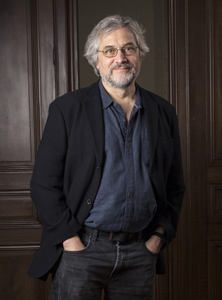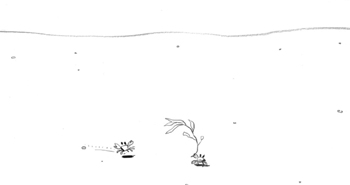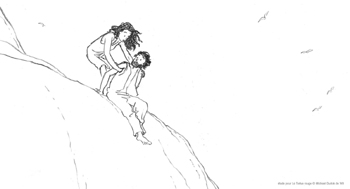 Michael Dudok de Wit`s THE RED TURTLE (La Tortue Rouge), a Studio Ghibli - Wild Bunch - Why Not Productions film. Image courtesy of Wild Bunch. © 2016 Studio Ghibli - Wild Bunch - Why Not Productions - Arte France Cinéma - CN4 Productions - Belvision - Nippon Television Network - Dentsu - Hakuhodo DYMP - Walt Disney Japan - Mitsubishi – Toho
Michael Dudok de Wit`s THE RED TURTLE (La Tortue Rouge), a Studio Ghibli - Wild Bunch - Why Not Productions film. Image courtesy of Wild Bunch. © 2016 Studio Ghibli - Wild Bunch - Why Not Productions - Arte France Cinéma - CN4 Productions - Belvision - Nippon Television Network - Dentsu - Hakuhodo DYMP - Walt Disney Japan - Mitsubishi – TohoInterviews, Information, Artwork and Videos For New Animated Movie Source: Wild Bunch, Studio Ghibli Official Movie Site: red-turtle.jp (Japan)
SPOILER WARNING: This article contains plot details from an upcoming movie.
THE RED TURTLE A FILM BY MICHAEL DUDOK DE WIT SCREENPLAY: MICHAEL DUDOK DE WIT ADAPTATION: PASCALE FERRAN AND MICHAEL DUDOK DE WIT FRANCE/BELGIUM – FORMAT: 1.85 SOUND: DIGITAL 5.1 – 1H20 SYNOPSIS Through the story of a man shipwrecked on a tropical island inhabited by turtles, crabs and birds, THE RED TURTLE recounts the milestones in the life of a human being.
INTERVIEW WITH MICHAEL DUDOK DE WIT Extracts from an interview with Bernard Génin, to be published in Positif N°665 (July/August 2016) - Among your animated shorts, at least two are now considered cult films. THE MONK AND THE FISH, produced at the studio Folimage in Valence won a César in 1996 and was nominated for an Academy Award. In 2001 FATHER AND DAUGHTER received widespread critical acclaim and won several awards (Annecy, Hiroshima, etc.) including an Academy Award. A little girl watches her father leave. His memory follows her throughout her life. Here you express an indefinable feeling: longing...
 French poster, courtesy of Wild Bunch. © 2016 Studio Ghibli - Wild Bunch - Why Not Productions - Arte France Cinéma - CN4 Productions - Belvision - Nippon Television Network - Dentsu - Hakuhodo DYMP - Walt Disney Japan - Mitsubishi – Toho
French poster, courtesy of Wild Bunch. © 2016 Studio Ghibli - Wild Bunch - Why Not Productions - Arte France Cinéma - CN4 Productions - Belvision - Nippon Television Network - Dentsu - Hakuhodo DYMP - Walt Disney Japan - Mitsubishi – TohoYes, it’s hard to define as it’s very subtle, but I think it’s something a lot of people have experienced. It’s a yearning for something that seems unattainable, a deep and silent desire. For an artist, this can be a quest for perfection, an ideal in music, drawing, poetry... A painful and yet beautiful absence. You cannot imagine the number of moving testimonies I received from friends and strangers alike, telling me the film evoked what they themselves had experienced. I’m incredibly lucky it has become a classic film. - You were a member of the jury at the 2004 Hiroshima Festival. Did you meet Isao Takahata there? Indeed, we exchanged a few words. He even spoke a little French. He loves French culture. Shortly afterwards, I was surprised to see him arrive with a translator at the Seoul Festival, where I was giving a seminar about my work to students. I thought he was just there to say hello, but he stayed for the whole conference! Perhaps he already had a collaborative project in mind. - In November 2006 you received an unexpected email from Tokyo. With two queries. The first was the Ghibli Museum asking for my permission to distribute FATHER AND DAUGHTER in Japan. The second was whether I would be interested in working with their studio on my very own feature film. Until then, I hadn’t really thought about a feature film. Some of my friends had been promised wonderful things, had gone to California only to return disappointed after having seen their projects revised by producers. But with Studio Ghibli, it’s different. They told me that we would be working under French law, which respects art films. They gave me several months to write the script. I had the idea of a man on a desert island, a theme that has since then become somewhat recurrent on television, but I liked this archetypal idea. I didn’t want to tell the story of how he survives, as this has been done so many times. I needed more than that. So I spent some time on one of the small Seychelles islands -- a name which evokes luxury vacations. But I made a simpler choice, living with locals for ten days. I would go for walks alone, observing everything and taking thousands of photos. The idea was to avoid the ‘holiday brochure’ aesthetic. My castaway couldn’t love the location -- he wants to return home at all costs, as the island is not so welcoming. There are dangers, extreme solitude, rain and insects...
Then I made a classic mistake: my script was too detailed. The film would have been too long. But the basis of the story was strong. The next step was the animatic, which is a very simplified version of the film, drawn with fixed, static images. I discovered that it was sometimes tricky to translate the story into a cinematographic language. There were kinks that I couldn’t smooth out. Pascal Caucheteux, my producer at Why Not Productions, suggested I meet Pascale Ferran. We saw each other regularly over the following months. We had in-depth discussions about the film as a whole, as we were unable to change isolated elements without affecting all the rest. She helped me to identify problems and to make the narrative clearer and more powerful. She also loved the idea that in animation films, the editing is so well thought out before the shots are made -- she made some valuable contributions to this process. - Once again, one of the themes is longing, the hero’s inner expectations while gazing at the sea... But also what you call timelessness. It’s a recurring theme in all your films -- you can feel it in the shots of the trees, the sky, the clouds, the whirling birds... Yes, these are pure and simple moments we are all familiar with. There is no past nor future, time stands still. - But time is circular too. Generations succeed one another. The child makes the same gestures as his father, climbs the same rocks, and endures the same dangers. In the animal kingdom, it’s another cycle: the dead fish feeds the flies, which are in turn eaten by the spider, the crab is carried away by the bird, etc... That’s right. The film tells the story in both a linear and circular manner. And it uses time to relate the absence of time, like music can enhance silence. This film also speaks of the reality of death. Man has a tendency to oppose death, to fear and fight against it, and this is both healthy and natural. Yet we can simultaneously have a beautiful and intuitive understanding that we are pure life and that we don’t need to oppose death. I hope the film conveys that feeling. - Another essential element is the first appearance of the turtle and the mystery that surrounds it.
The idea of creating a story with a big turtle came to me quite early. It had to be a majestic and respected sea creature. The sea turtle is peaceful and solitary; it disappears into the depths of the ocean for long periods of time and conveys an impression of quasi-immortality. Its deep red color is fitting and makes it stand out visually. We gave a lot of thought to how much mystery we wanted to preserve in the story. In Studio Ghibli films for example, I think the presence of the mysterious is very well handled. Of course mystery can be wonderful, but not to the point where it disconnects the audience from the story. It has to be managed very subtly... And without words, since there is no dialogue in the film. It’s so easy to explain things through dialogue but there are other ways of course, such as the behavior of the characters, the music and the editing. And without dialogue, the sounds of the characters breathing become naturally more expressive. - Let’s talk about technique: apparently, you discovered digital at Prima Linea Productions. That’s right. Prima Linea is the studio -- in Paris and Angoulême -- where we made the film. While we were doing our first animation tests, another crew was finalizing the film WOLFY, THE INCREDIBLE SECRET, using Cintiq, a digital pen that allows you to draw on a tablet that is also a monitor. With this tool, you can instantly visualize the results of your animation, without having to scan drawings separately. It’s more economical, gives you more creative freedom and increased control for retouching. We animated two versions of the same shot, one with pencil on paper and the other with this digital pencil. The line of the digital pencil was more beautiful and that convinced us. For the backgrounds, we chose a different process. The drawings were made with charcoal on paper, very freely, with broad strokes smudged with the palm of the hand. This artisanal quality was very important and gave the image a lovely, grainy texture. Only the raft and turtles were digitally animated. It would have been hell to animate them in 2D. As everything is finalized in the same graphic style, you can’t tell it’s digital. During the production I didn’t do any animation or scenery, only small touch ups. - How was the music conceived?
 Image courtesy of Wild Bunch. © 2016 Studio Ghibli - Wild Bunch - Why Not Productions - Arte France Cinéma - CN4 Productions - Belvision - Nippon Television Network - Dentsu - Hakuhodo DYMP - Walt Disney Japan - Mitsubishi – Toho
Image courtesy of Wild Bunch. © 2016 Studio Ghibli - Wild Bunch - Why Not Productions - Arte France Cinéma - CN4 Productions - Belvision - Nippon Television Network - Dentsu - Hakuhodo DYMP - Walt Disney Japan - Mitsubishi – TohoThe music is key as there is no dialogue. I didn’t have a clear idea of a specific musical style. Laurent Perez del Mar made a few suggestions including a very beautiful melody that was perfect for the main theme. I was delighted. He was quick to suggest music where I would not have thought to have any, and he was right. He often surprised me. - Can you tell us about your meetings with Isao Takahata? In fact, there were three producers from the start: Isao Takahata and Toshio Suzuki, the two producers from Studio Ghibli, and Vincent Maraval from Wild Bunch. We met a few times at Studio Ghibli and Isao Takahata and Toshio Suzuki also came to France. My conversation was mainly with Takahata. Sometimes we discussed details such as the characters’ clothes, for example, but we mostly talked about the story, the symbolism and philosophical points: what the film truly wants to express. There were times when our cultural differences could be felt. For example, there is a fire in the story, and for Takahata, fire had a slightly different symbolic value than it did for me. Overall, we were on the same wavelength, thankfully, and I found our conversations sensitive and passionate. He was extremely involved and he is a highly qualified artistic producer. - How long did the production take? I started to write the script and draw the animatic in 2007. This took quite a long time and that’s when I realized that the storyline didn’t quite hang together. For several years I worked continually on the project (sometimes alone, sometimes with co-workers), but I realized this was too time-consuming. I’m grateful to my producers, who reassured me and were in fact, not surprised that it was taking so long. They pointed out that the most costly phase would come later, and that it was wiser to start production with a solid storyline. Some producers would have decided to finalize the story as we were animating, to avoid wasting too much time. I can understand that, but it would have been too risky for me. Production began in 2013 at Prima Linea in Angoulême; the artistic side was managed by Ghibli, Why Not and Prima Linea, where I could rely on the excellent head animator Jean-Christophe Lie, director of ZARAFA and one of the pillars of this film.
 Image courtesy of Wild Bunch. © 2016 Studio Ghibli - Wild Bunch - Why Not Productions - Arte France Cinéma - CN4 Productions - Belvision - Nippon Television Network - Dentsu - Hakuhodo DYMP - Walt Disney Japan - Mitsubishi – Toho
Image courtesy of Wild Bunch. © 2016 Studio Ghibli - Wild Bunch - Why Not Productions - Arte France Cinéma - CN4 Productions - Belvision - Nippon Television Network - Dentsu - Hakuhodo DYMP - Walt Disney Japan - Mitsubishi – TohoINTERVIEW WITH JEAN-CHRISTOPHE LIE Animator on THE HUNCHBACK OF NOTRE DAME (1996), TARZAN (1999), THE TRIPLETS OF BELLEVILLE (Belleville Rendez-vou, 2003); director of the short film THE MAN IN THE BLUE GORDINI (2009) and the feature film (co-directed by Rémi Bezançon) ZARAFA (2012) and chief animator on THE RED TURTLE. Interview by Bernard Génin. - When did you first discover the work of Michael Dudok de Wit? It was a screening of THE MONK AND THE FISH, at Annecy in 1995. I had just graduated from Gobelins and I voted for him for the Prix du Public! - You had no idea that twenty years later, he would refer to you as “one of the pillars” of his first feature film. How did you meet? We met at the Prima Linea studio in Paris. I was finalizing my feature film ZARAFA and he was doing some compositing1 tests for his own film. I told him straight away that I was on board. And I was lucky to be involved firstly as an animator and, after ten months, as chief animator.
 Image courtesy of Wild Bunch. © 2016 Studio Ghibli - Wild Bunch - Why Not Productions - Arte France Cinéma - CN4 Productions - Belvision - Nippon Television Network - Dentsu - Hakuhodo DYMP - Walt Disney Japan - Mitsubishi – Toho
Image courtesy of Wild Bunch. © 2016 Studio Ghibli - Wild Bunch - Why Not Productions - Arte France Cinéma - CN4 Productions - Belvision - Nippon Television Network - Dentsu - Hakuhodo DYMP - Walt Disney Japan - Mitsubishi – Toho- How did you work together? Michael had drawn a storyboard on paper and produced an animatic2. When we started production, we moved on to Cintiq tablets, a technique with which he wasn’t yet familiar. You draw directly on graphic tablets with a stylus and see the result instantly on the monitor. Soon he no longer had the time to draw or animate. He was there to guide us and help us to improve the film. There was a constant dialogue between him and the animators. He is probably one of the greatest perfectionists I’ve met. But he’s very open to different viewpoints, and that’s very stimulating. We had long and passionate discussions. - How long did the production take? Michael set himself a pace that suited him from the start. The production of a feature film generally takes about ten months. He requested a smaller than usual animation team -- a dozen animators -- and Prima Linea suggested a two-year schedule. One of the first steps was the layout of the backgrounds on paper3, which Michael took part in, followed by the layout and posing (the characters), which was done on Cintiq. - How were the backgrounds designed? The backgrounds were drawn with charcoal on paper by a special team, and then scanned to obtain tonal values in black and white. Colors were then integrated with Photoshop and everything was then blended to obtain light and shadow effects. - The characters’ body language is very realistic, far from a cartoon aesthetic. Yes, but to achieve that result, nothing was rotoscoped -- as the Fleischer brothers did in the 1920s, tracing real images. We used what is termed analytic animation: actors are filmed and their strongest poses are isolated. The camera angles are readapted in the layout, then everything is redrawn, as you would do in a life drawing class. The footage of the actors is only used as a reference. Michael also spent time on an island, and all the photographs he took there proved invaluable; they helped us put ourselves in a survival frame of mind, but were also extremely helpful for the team of animators working on the scenery, as Michael had photographed the sky from sunrise to sunset, studying the effect of the light on the clouds...
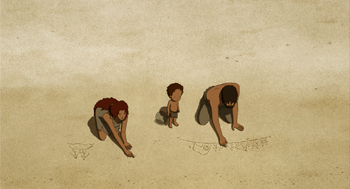 Image courtesy of Wild Bunch. © 2016 Studio Ghibli - Wild Bunch - Why Not Productions - Arte France Cinéma - CN4 Productions - Belvision - Nippon Television Network - Dentsu - Hakuhodo DYMP - Walt Disney Japan - Mitsubishi – Toho
Image courtesy of Wild Bunch. © 2016 Studio Ghibli - Wild Bunch - Why Not Productions - Arte France Cinéma - CN4 Productions - Belvision - Nippon Television Network - Dentsu - Hakuhodo DYMP - Walt Disney Japan - Mitsubishi – Toho- The beauty of the light and skimming shadows is breathtaking... It’s almost a signature of Michael’s work, recurring in his short films and even his adverts in the UK. Everything was storyboarded. The team interpreted his style to perfection. - At the very beginning of the film, a giant tidal wave appears suddenly: how do you work on this type of scene? With a lot of video footage, images of tsunamis and storms, but also of surfing... I mostly worked on characters, but ten or so animators were working on the special effects: waves and backwash. It’s a very long process, with minute details you barely see, but which give the film its distinctive mood. - Were the fire and the smoke digital? The smoke yes, but not the fire. Originally, in the draft, it was intended to be a line drawing animation on Cintiq, like the characters. Then with transparency effects, the compositing phase adds color. 3D animation was used for two elements: the turtle and the raft. These were digitized and then, in the sequences where there is an interaction with a character, the 3D animator would work with the 2D animator. In one scene, the man falls into the water and swims away, pursued by the turtle. On the screen I had a turtle in 3D, but subsequently every drawing was retraced to obtain a 2D rendering. It was the same for the raft, first digitized and then retraced, image by image. The hardest part for the animators was to recreate the projected shadows that followed the curves of each bamboo shaft and which had to be animated manually. - You couldn’t be inspired by the music, as it hadn’t yet been composed. Michael had taken a firm stance: not to give in to an emotion triggered by the music. He wanted the gestures, first and foremost, to inspire the emotion.
- What do you consider the theme of the film? The circle of life, told in a very modest and natural way, with an element of love but also a hint of cruelty. The scene where a crab is cast off by the child but immediately snatched up by a bird, says everything about destiny... - What was the hardest part? Everything? Of course. On this type of film, it’s difficult to validate a shot. We were far from thinking that the first draft was “the one.” We were pushing back, always wanting to rework things... Adding an abundance of detail can be spectacular but there’s also a certain easiness to it somehow. Here we were always working towards something more pared down. It was difficult, but when we saw the beauty of the images that appeared every day, it didn’t seem so painful. When you feel, just by seeing the animatic, that a beautiful film is in the making, you accept all the difficulties. 1. Composition: A compilation, in one single image of different files (scenery, colours, animation, special effects, etc)? 2. Animatic: A preliminary version of the film produced by shooting successive sections of the storyboard? 3. Layouts: Preparing for the mise-en-scene and planning the camera moves?
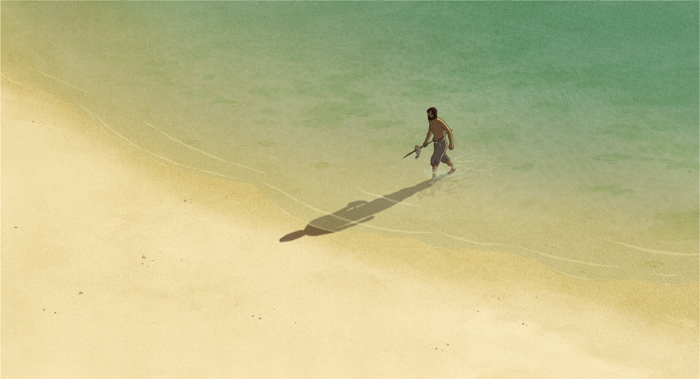 Image courtesy of Wild Bunch. © 2016 Studio Ghibli - Wild Bunch - Why Not Productions - Arte France Cinéma - CN4 Productions - Belvision - Nippon Television Network - Dentsu - Hakuhodo DYMP - Walt Disney Japan - Mitsubishi – Toho
Image courtesy of Wild Bunch. © 2016 Studio Ghibli - Wild Bunch - Why Not Productions - Arte France Cinéma - CN4 Productions - Belvision - Nippon Television Network - Dentsu - Hakuhodo DYMP - Walt Disney Japan - Mitsubishi – TohoINTERVIEW WITH LAURENT PEREZ DEL MAR - Were you familiar with Michael Dudok de Wit’s work before working on his first feature film? Yes, I had seen his short film FATHER AND DAUGHTER, which I loved. - This wasn’t your first time composing music for an animated film. (FEAR(S) OF THE DARK, ZARAFA, WOLFY, THE INCREDIBLE SECRET and ANIMAL KINGDOM: LET`S GO APE. For ZARAFA, you were inspired as soon as you read the script. How was it for THE RED TURTLE? It was thanks to Christophe Jankovic and Valérie Schermann (with whom I had already worked on three films for Prima Linea) that I came to work on this project. The film was being edited. I saw a few images and composed a first demo for one of the scenes, which was then submitted to Michael and the producers. They liked the demo and I was chosen.
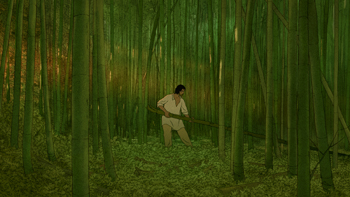 Image courtesy of Wild Bunch. © 2016 Studio Ghibli - Wild Bunch - Why Not Productions - Arte France Cinéma - CN4 Productions - Belvision - Nippon Television Network - Dentsu - Hakuhodo DYMP - Walt Disney Japan - Mitsubishi – Toho
Image courtesy of Wild Bunch. © 2016 Studio Ghibli - Wild Bunch - Why Not Productions - Arte France Cinéma - CN4 Productions - Belvision - Nippon Television Network - Dentsu - Hakuhodo DYMP - Walt Disney Japan - Mitsubishi – TohoAfter that I met Michael and we talked about what he had in mind musically for his film, what was important for him. I really enjoyed this first meeting. Michael conveyed his enthusiasm, his passion and most of all, his great sensitivity. It was very inspiring. I wrote the theme music that very evening, recorded it the following day and sent it to Michael. It all happened quite fast. Then I worked as the film was being edited. - The film has no dialogue, it’s very meditative with long silent interludes. How do you decide which moments call for music? A lot of it comes down to instinct when you decide to include music or not in a scene. First I watched the film alone, then with Michael and Béatrice (producer at Why Not), pausing to share our impressions. We agreed on the main parts where music seemed essential, and those that did not call for it. Sometimes I made unexpected suggestions that we kept in certain places. I observed three imperatives for writing the score: 1. Respect silence, and the sounds of nature 2. The music, sounds and natural ambience should blend seamlessly with one another 3. Create a rhythm in the narrative with music Thereafter, during the screenings with the successive teams, we refined things until we obtained the right balance and rhythm. - Sound is a vital element of the film, the sounds of nature: wind, rain etc. Is it a challenge to compose with this? We worked closely with the sound editor Sébastien Marquilly and the dubbing mixer (for the film and the music) Fabien Devillers. They did an incredible job. I would regularly drop by their studio to listen to what they were doing and to compose according to what I was hearing. In return, I would also send them demos of the music as soon as it was approved, so that they too could adapt. I think that’s one of the phases I found most interesting: being able to create the subtlest coexistence between the sounds of nature and the music.
Incidentally, I used a lot of wood and bamboo for the percussion. For example, all the ‘shaker’ sections were made using bamboo leaves I had handpicked and then recorded in my studio. I also used a wooden udu (a pot-shaped idiophone from Nigeria) to obtain an aquatic and wood-like tonality in the large percussions. In the last stages of post-production, we decided with the dubbing mixer and the producers to simultaneously mix the music and the sound -- this is very rare -- always keeping in mind the coherence of an indivisible ensemble of music and sounds. We even tuned-up (in their tonality) the atmospheres, the wind, the birds and the music: an experience that really made us feel like we had reached the very limits. It was a deeply satisfying way of working. - Did you make a precise choice of instruments from the start? Did Michael, who is a good pianist as well as a fantastic graphic artist, get involved? Were you on the same wavelength from the beginning? Yes, in our first meeting Michael told me he wanted a cello, a ternary rhythm and analogue textures. He already had a very precise idea and I understood straight away that he had a good knowledge of music. I suggested natural percussions (bamboo), native flutes and the quest for a melodic and harmonic simplicity, which I felt was consistent with the visual aesthetic of the film and would also serve to reach an emotional essence. This appealed to him straight away. It’s always tricky to work with a director who is both a musician and a cultured music lover, but it’s also extremely motivating and stretching. - What were the greatest challenges? We didn’t come across any hurdles during the writing phase. As soon as the theme was written, we understood that we shared the same artistic vision for the film. I began to work alone and then made him listen to pieces as they were completed. Everything happened very naturally. Michael is one of those directors who thrives on the expertise of those working alongside him -- like Scorsese, for example -- as opposed to other directors who want their input to dominate everything. So you feel very free and confident and sometimes allow yourself a certain audacity. - The mood changes a number of times throughout the film (violent storms, dreams of the wooden bridge and the castaway’s take-off, a tsunami that destroys everything). How did you address these ‘‘fortissimo’’ moments?
 Image courtesy of Wild Bunch. © 2016 Studio Ghibli - Wild Bunch - Why Not Productions - Arte France Cinéma - CN4 Productions - Belvision - Nippon Television Network - Dentsu - Hakuhodo DYMP - Walt Disney Japan - Mitsubishi – Toho
Image courtesy of Wild Bunch. © 2016 Studio Ghibli - Wild Bunch - Why Not Productions - Arte France Cinéma - CN4 Productions - Belvision - Nippon Television Network - Dentsu - Hakuhodo DYMP - Walt Disney Japan - Mitsubishi – TohoI don’t think too much when I write, I let myself get carried away by the emotion in the moment. The example of the tsunami is interesting, as originally, we hadn’t planned to have music for this scene. It was a very realistic scene. One day, I told Michael to sit in my place and to listen. I wanted to ask him to play devil’s advocate, something I like to do when I can. As it happens, instead of writing music for an action scene, which would have paraphrased the image (something I rarely find interesting in film music), I chose to immerse myself with the characters, swept away by this force of nature, and to sustain their emotions, their distress, their survival instinct, by maintaining this question of whether they would live or die. That’s what I find interesting in that sequence, where the sound editing epitomizes the violence of the elements and the music keeps us close to the characters, the empathy that has grown with us throughout the film. - The use of color is very particular, with certain scenes almost monochromatic. Did this inspire you? I really liked this commitment to making the night monochrome. The beauty of the colors and the choices made here must have influenced my way of writing, but I didn’t intellectualize it at all. - Composing for a film co-produced by Studio Ghibli, under the shadow of Joe Hisaishi’s shadow... was that intimidating? Of course it’s awe-inspiring when you talk about it, but from the moment you embrace the film’s atmosphere and live with it, on this island every day for weeks, you stop thinking about all that. I wrote this music paying no attention to what was going on around the film, as I do with all my projects. Then one day there’s a screening and you realize your name follows prestigious names in the credits. That’s when you feel dizzy again and you realize how privileged you were to have worked on such a beautiful creation. - Is composing for an animated film different to working on a live-action film? I think that just as animation sometimes allows you to reach a very high level of fantasy, poetry, beauty and freedom with the mise-en-scène, the music can be written in a totally free and inspired manner. But that depends greatly on the project.
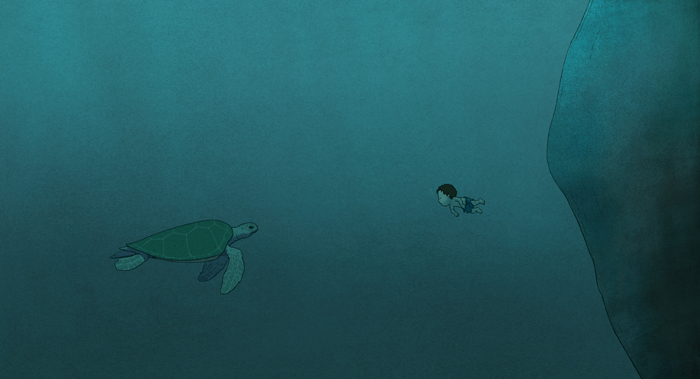 Image courtesy of Wild Bunch. © 2016 Studio Ghibli - Wild Bunch - Why Not Productions - Arte France Cinéma - CN4 Productions - Belvision - Nippon Television Network - Dentsu - Hakuhodo DYMP - Walt Disney Japan - Mitsubishi – Toho
Image courtesy of Wild Bunch. © 2016 Studio Ghibli - Wild Bunch - Why Not Productions - Arte France Cinéma - CN4 Productions - Belvision - Nippon Television Network - Dentsu - Hakuhodo DYMP - Walt Disney Japan - Mitsubishi – TohoINTERVIEW WITH ISAO TAKAHATA - Did you know Michael from his first short film THE MONK AND THE FISH? Yes, I loved it at first sight. Everything -- the drawing, animation, music, story and sense of humor -- was magnificent. I fell in love with it. I was especially astonished by its powerful sense of reality, despite its simplicity. - Do you remember your reaction the first time you saw FATHER AND DAUGHTER? Of course. I watched it on TV when it received the Grand Prix at the Hiroshima International Animation Film Festival. It was a very pleasant shock, and I was deeply impressed. This must be the best of the best short animation, I thought. I immediately watched it again and again on video. I cannot begin to guess how many times I have seen it. Everything about this work is impressive.
 Japanese poster, courtesy of Wild Bunch. © 2016 Studio Ghibli - Wild Bunch - Why Not Productions - Arte France Cinéma - CN4 Productions - Belvision - Nippon Television Network - Dentsu - Hakuhodo DYMP - Walt Disney Japan - Mitsubishi – Toho
Japanese poster, courtesy of Wild Bunch. © 2016 Studio Ghibli - Wild Bunch - Why Not Productions - Arte France Cinéma - CN4 Productions - Belvision - Nippon Television Network - Dentsu - Hakuhodo DYMP - Walt Disney Japan - Mitsubishi – TohoI was particularly impressed that while the style is simple, Michael depicted the landscape of the Dutch polder and its structure so precisely, and presented it to the audience as a unified world. He created a synchronization of two times: the time of a girl who grows up, becomes a parent, and then ages, versus the time of the ocean beyond the dyke as it gradually dries up and becomes an arid flatland. The life of a human and the unhurried changes of nature are synchronized perfectly. He ends with a scene that moves every kind of audience: a scene that conveys his unique -- and clearly not Christian -- view of life and death, a view that is very close to that of the Japanese. I have given many lectures and classes, ranging from one-and-a-half to three hours, focusing on this short film alone, and I hope to write a book about this masterpiece, as I did about Yuri Norstein’s TALE OF TALES. By the way, when I served on the jury of the Chiavari International Animation Film Festival in 2004 to select the best short animation of the 21st Century, I voted for FATHER AND DAUGHTER, along with Michel Ocelot and other jurors, without qualification. - In 2004, Michael was a member of the jury at the Hiroshima festival. Did you meet? I met Michael once in Hiroshima. I believe it was the same trip on which he brought his wife and children and walked the World Heritage Kumano Kodo (trail) after the festival -- and broke his leg. I also met him when he conducted a lecture and workshop at an animation festival in Seoul, Korea. I saw his THE AROMA OF TEA, and I asked him to create a piece based on symbolism, not on abstraction. - Do you agree that in its simplicity, his graphic style is very close to Japanese art, oriental calligraphy, and especially what you yourself look for in your films (MY NEIGHBORS THE YAMADAS, THE TALE OF THE PRINCESS KAGUYA) I agree that we both choose a style that leaves white space on the screen instead of drawing everything, aiming to stimulate the audience to use its imagination actively. Michael’s drawings and animation, however simple, never lose their sense of the real, and what we have pursued is quite similar. I also feel empathy with his somehow Eastern view of nature. - You suggested the release of FATHER AND DAUGHTER -- a short film -- in Japan. Was it screened on television or in a special short films program? Did you meet the public and what was the reaction to the film?
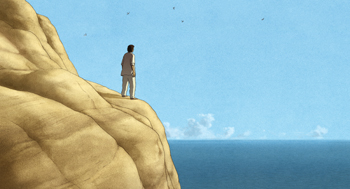 Image courtesy of Wild Bunch. © 2016 Studio Ghibli - Wild Bunch - Why Not Productions - Arte France Cinéma - CN4 Productions - Belvision - Nippon Television Network - Dentsu - Hakuhodo DYMP - Walt Disney Japan - Mitsubishi – Toho
Image courtesy of Wild Bunch. © 2016 Studio Ghibli - Wild Bunch - Why Not Productions - Arte France Cinéma - CN4 Productions - Belvision - Nippon Television Network - Dentsu - Hakuhodo DYMP - Walt Disney Japan - Mitsubishi – TohoI was not the only one who suggested that FATHER AND DAUGHTER should be released in Japan; Toshio Suzuki did as well. He also adores this work. Unfortunately I couldn’t really be of help for the Japanese release at that time. (I also disagree with the Japanese title KISHIBE NO FUTARI -- The Two on the Bank. The title should have been a faithful translation of FATHER AND DAUGHTER). As far as I know, those who have seen FATHER AND DAUGHTER are, without exception, deeply impressed and moved, and love it -- for all of them, it allows time to reflect on their own views of life and death. - It was your idea that Studio Ghibli should produce Michael’s first feature film. Was it easy to convince Mr Suzuki? In fact, that’s not accurate. It was Toshio Suzuki who wanted Michael to create a full-length animated feature... who wanted to see that film. I do not have the ability to produce and was therefore surprised when Michael was kind enough to credit me as the film’s Artistic Producer. Personally I don’t think I played such an elevated role, and so I don’t think I deserve the credit. - Did you collaborate on the script and propose any modifications? Did you follow the progress of the film in France? With Toshio Suzuki and a few others at the studio, I read the scripts and watched story reels that Michael sent, and exchanged opinions. I was in charge of drafting comments from the studio. My position for this project was as follows: I am a filmmaker. I have always believed that the content and the expression of a film should be decided and created as the director wants. I have been fortunate to have worked in such conditions throughout my career. For that reason, having been given such a blessing, I insisted that Michael have and use that privilege. So when I had to express opinions on the film, I always tried to stand by Michael, and make statements on his behalf. I used my best efforts to understand his intentions, and eventually to understand him as well, by reading the scripts and watching the reels very thoroughly. Through this process, I tried to tell him as much as possible our thoughts on what we found impressive, good, understandable, etc.
 © 2016 Studio Ghibli - Wild Bunch - Why Not Productions - Arte France Cinéma - CN4 Productions - Belvision - Nippon Television Network - Dentsu - Hakuhodo DYMP - Walt Disney Japan - Mitsubishi – Toho
© 2016 Studio Ghibli - Wild Bunch - Why Not Productions - Arte France Cinéma - CN4 Productions - Belvision - Nippon Television Network - Dentsu - Hakuhodo DYMP - Walt Disney Japan - Mitsubishi – TohoDuring each discussion at the studio there were always various opinions, including: “I don’t agree”, “I cannot understand” or “There’s something missing”. In those cases, I tried to think of the best possible way for Michael to convey what he wanted to the audience. Then I wrote to him: “If your intention is this and this, then I suggest that and that”, or “We think this way would reach the audience better.” These were all opinions, not suggestions. We did not want to force our opinions on Michael at all. And we supported all of his final decisions. Mr. Suzuki also respects Michael. He trusts his creativity and looked forward to the finished work. Our anticipation only increased as the completion of the film grew near. When I saw the completed film, from my heart, I was more than satisfied. - What do you think of the animation made in a French studio, in Angoulême? Do you perceive big cultural differences between the way French animators work compared to Japanese animators at Studio Ghibli?
I say: “Bravo!” Michael has a very unique style. It is simple, uncluttered, but not purely graphical, and it demands real feeling. Previously, he had drawn his animation all by himself. It must have been extremely difficult for animators to follow his style and animate these drawings with a sense of the real. I would like to praise the crew gathered in Angoulême -- you did very well! I can only say this from looking at the final version of the film, but I can surmise that our styles are more similar than ever before. - How would you sum up THE RED TURTLE? After FATHER AND DAUGHTER, Michael has succeeded again in depicting the truth of life, simply yet profoundly, and with real heart. It is an astonishing accomplishment. Humankind cannot live without maintaining a balanced relationship with nature founded upon equality and empathy. And in the eyes of this man, as is more or less clear to everyone, the red turtle is indeed his wife. This is how I understand Michael’s message. I cannot express sufficiently my deep respect for, and identification with, the fact that there exits a powerful resonance, on the subject of man and nature, between the line that runs through all Michael’s work and ideas that have existed in Japan since ancient times. I would also like to share with international audiences the fact that, in Japan, there are many tales based on marriages between different kinds of beings. In fact, it is said that a grandmother of the first Emperor was a ferocious shark.
INTERVIEW WITH PASCALE FERRAN - This is your first time working on an animation film. Was this a genre that you followed? I don’t really think in terms of cinematic genres. Certain animation films are masterpieces on a par with certain live action films. For example, films by Miyazaki and Takahata have a special place in my personal hall of fame. But it’s fair to say that animation films are doing particularly well at the moment. I recently realized that among the directors whose work I most anticipate, alongside Bong Joon-ho and Apichatpong Weerasethakul, are Pete Docter and Mamoru Hosoda, the director of WOLF CHILDREN, a film I love. - Can you tell us about your first meeting with Michael Dudok de Wit? I was contacted by producer Pascal Caucheteux, of Why Not Productions, who must have thought I would respond to the world of the film. They were particularly fond of this project but felt that the screenplay needed to be polished. He therefore asked me to step in as a consultant. I was delighted, as I love working on screenplays that aren’t my own, and the timing was good -- it was in the spring of 2011 and I was waiting for funding for BIRD PEOPLE so I had a few weeks to spare.
He didn’t send me the script but the animatic -- a concise version of the animated storyboard, in black and white, following the correct timing and pace of the film. The running time was approximately an hour and fifteen minutes. Here I discovered a surprising new method of working -- drawing before writing -- and Michael’s drawings, which, even as rough sketches, were so beautiful. I instantly developed a sense of intimacy with the film, probably because it is close to my relationship to the world: the intertwining of life and death, the prevalence of nature, the enchantment of fables. But also, perhaps its most Japanese aspect: our relationship to adversity. At a given moment, catastrophes occur and we must accept them, face them and then rebuild. I feel strangely close to this fatalistic, almost serene response when faced with certain forms of adversity. - What were your first impressions of the screenplay? For me, it was quite simple. The film was divided into three almost equal parts: the beginning until the turtle’s first appearance, then the transformation and the encounter between the man and the woman, and finally the arrival of the child at the end. I found the first act very convincing. It was divided into six chapters, which weren’t units of time but units of narrative. Each chapter focused on one event (the storm, the discovery of the island or the first attempts to leave it, and so on). These either took place over a few hours or several weeks, which resulted in a very particular form. I therefore suggested reworking the next two acts, to enrich them and make them work better as a whole, but relying on what the first part had shed light on in terms of a narrative structure. The good news was that there weren’t many new sequences to think up and therefore to draw... ten, perhaps. However, we had to agree on what we wanted to retell and replace following this new alignment, sometimes moving certain sequences, sometimes either shortening them or developing them further. Everybody, and Michael in particular, was convinced by my suggestions, and from then on he and I started working together. - Michael says you helped resolve some thorny issues. Can you tell us more about this? THE RED TURTLE is his first feature film. I think at that stage of the conception of the film, he was a little disorientated, sometimes torn between contradictory directions. It was a lot easier for me who had a fresh eye and a little more experience working on screenplays. But above all, I loved the project including certain “empty” or reflective moments, and we quickly came to trust each other. He realized he could rely on me for pragmatic help in solving questions that seemed complex to him, and whose solutions were often quite simple. I tried as best I could to reintegrate the elements Michael had thought up, as they were visually superb and extremely evocative for him. I was therefore acting more as a co-writer who helps the director compose his own narrative, than a screenwriter who invents a story. - Can you give us an example of sequences that were developed at this stage?
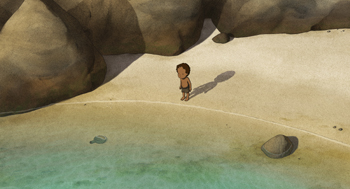 Image courtesy of Wild Bunch. © 2016 Studio Ghibli - Wild Bunch - Why Not Productions - Arte France Cinéma - CN4 Productions - Belvision - Nippon Television Network - Dentsu - Hakuhodo DYMP - Walt Disney Japan - Mitsubishi – Toho
Image courtesy of Wild Bunch. © 2016 Studio Ghibli - Wild Bunch - Why Not Productions - Arte France Cinéma - CN4 Productions - Belvision - Nippon Television Network - Dentsu - Hakuhodo DYMP - Walt Disney Japan - Mitsubishi – TohoEverything surrounding the character of the woman was less developed. She was a figure, barely a character. Several scenes were produced to give her a sense of autonomy. I also insisted on the importance of the face-to-face encounter between the man and the turtle: the first look they exchange underwater. At the time, the film ended with the son’s departure. I suggested we extend the film to show how the parents’ life continues without him. I really like certain instances of their old age, when they look at each other or when they dance together. But above all it reinforced the notion that we are only passing through this world and Michael was quick to embrace this idea. I think there were also fewer scenes with the child. We developed his character, while on the other hand, we edited down the passage with the tsunami. I felt it was important that the child understood where he came from, which led to the scene with the drawings in the sand. I thought it was beautiful that the parents told their son about his family heritage. The idea of heritage or transmission became one of the themes that runs throughout the film, not only from a family aspect but also on a cosmogonic level: how nature, from which we all come, is a sort of shared heritage, transmitting things that we will in turn have to pass on. We worked together for about three months. Every time we agreed on a new scene, Michael would draw it whilst I would continue working on the rest of the screenplay. He then scanned all the drawings, which we then integrated into the new animatic, from which the film was produced. At that point, I then went back to working on my own film. I only discovered THE RED TURTLE -- completed and with the soundtrack -- years later. I was stunned by the visual beauty of the film, the extraordinary quality of the animation and all the work that had been done on the soundtrack (sound editing, music, mix...), which is of course vital for this film. I think they did an incredible job.
 Image courtesy of Wild Bunch. © 2016 Studio Ghibli - Wild Bunch - Why Not Productions - Arte France Cinéma - CN4 Productions - Belvision - Nippon Television Network - Dentsu - Hakuhodo DYMP - Walt Disney Japan - Mitsubishi – Toho
Image courtesy of Wild Bunch. © 2016 Studio Ghibli - Wild Bunch - Why Not Productions - Arte France Cinéma - CN4 Productions - Belvision - Nippon Television Network - Dentsu - Hakuhodo DYMP - Walt Disney Japan - Mitsubishi – TohoPRIMA LINEA Our studio, which is based in both Paris and Angoulême, generally works exclusively on Prima Linea Productions’ own short and feature films. However, when Pascal Caucheteux from Why Not Productions introduced us to Michael Dudok de Wit’s THE RED TURTLE in the summer of 2010, we were immediately excited. The animatic, and the colored reference images Michael had drawn, convinced us that this was a truly exceptional project, and our feeling was confirmed when we met Michael. We therefore offered to oversee the production of the film, with an unusual work structure based on a small team who would work for longer than usual, organized in a way that would allow the director to supervise the animators and designers directly. Mr. Suzuki’s visit to the studio was a memorable event for everyone.
To define the artistic requirements, adapt to Michael’s way of working and establish a minimum yet efficient cost, the producers -- Ghibli, Wild Bunch and Why Not -- agreed to a test phase which began in January 2011 at the Paris studio, where Michael worked every day. At this point, the traditional method of drawing on paper technique was envisaged. Test shots served as references for the animation style, aspect of the line, choice of tools, treatment of the image in compositing, etc. They also helped confirm our set quotas. Michael, who was used to working alone or with a small number of co-workers, took some time to review the structure of the teams. This phase allowed him to determine exactly what could and could no longer be modified at each stage of the production of a feature film. As Michael was finalizing the animatic, Pascal Caucheteux suggested the assistance of a co-writer, which led to the very fruitful collaboration with Pascale Ferran. In September 2011, the five test shots were completed and in January 2012, the animatic was finalized. That autumn, Michael visited Angoulême (where we intended to produce THE RED TURTLE) for an event organized by the teams working on the film in progress there: WOLFY, THE INCREDIBLE SECRET. During this visit, we presented Michael with the traditional animation technique drawn directly on to a tactile screen (the same technique used for WOLFY). He returned to London with a Cintiq tablet and made some tests, which we followed via Skype. Production was launched in July 2013, with a very small team of carefully selected artists. The layout of the scenery began, even though Michael felt the design of the vegetation wasn’t yet strong enough and required development, as did the character of the woman. Then came the animation with Jean-Christophe Lie, with whom Michael was particularly thrilled to work. Once more we discovered Michael’s perfectionism and how his outlook embraces all aspects of the film, right down to the tiniest details.
 Image courtesy of Wild Bunch. © 2016 Studio Ghibli - Wild Bunch - Why Not Productions - Arte France Cinéma - CN4 Productions - Belvision - Nippon Television Network - Dentsu - Hakuhodo DYMP - Walt Disney Japan - Mitsubishi – Toho
Image courtesy of Wild Bunch. © 2016 Studio Ghibli - Wild Bunch - Why Not Productions - Arte France Cinéma - CN4 Productions - Belvision - Nippon Television Network - Dentsu - Hakuhodo DYMP - Walt Disney Japan - Mitsubishi – TohoAmongst the particularities of the project we should mention the great number of special effects which interacted more or less with the animation (including numerous waves, backwashes and storms, all with carefully measured rhythms and intensities calibrated to moments of the film), as well as the small number of shots (651, as opposed to the more standard thousand) with an average duration of more than 7 seconds. It was decided that the rafts and the turtles would be modeled in 3D to serve as a starting point for the animators, from which emerged the idea that a reference video would be extremely useful, as each and every movement had to be fully thought out. Each pleat of fabric, each wave of hair: nothing was left to chance. As Michael wanted to share everyone’s work with the whole team, a weekly screening of the most recently validated sections quickly became an important ritual for the team. The production eventually found a steady pace guided by an attentive and dedicated leader. A crew of Dutch documentary makers made regular visits to film the men and women working alongside Michael, with the idea of producing an intimate documentary record of this long-term project. At the 2015 Annecy Film Festival, Michael revealed a first look at THE RED TURTLE to a full house with a making-of presentation. The audience was moved by this sensitive presentation of his work, starting with the origin of the project at Studio Ghibli. In May 2015, the compositing team gathered in Marcinelle, Belgium, and were joined a few weeks later by the production teams and the artists working on finalizing the animation drawings, shadows and special effects. Laurent Perez del Mar was confirmed as the film’s composer. As the final editing deadline approached, many musical scores remained to be developed. By November 2015 everything was finalized for the final editing. The majority of the hundred or so collaborators the film required had now finished their work, but a final chapter remained before the film’s release. Post-production focused firstly on the sound: sound effects, background noises and the ambient presence of characters were produced in the auditoriums of Piste Rouge, the finishing touches applied to the image during the digital grade at Mikros and the last musical recordings for the final mix completed by early 2016. This wonderful adventure having reached its conclusion, it nonetheless has, as we will see, a lot of joy to offer!
CREDITS LA TORTUE ROUGE French Distributor: Wild Bunch Release Date: June 29, 2016 ??????? ?????? (Reddo Taatoru Aru Shima no Monogatari) Red Turtle: The Story of an Island Japanese Distributor: Toho Release Date: September 17, 2016 THE RED TURTLE US Distributor: Sony Pictures Classics Release Date: tba Director: Michael Dudok de Wit Original Story: Michael Dudok de Wit Screenplay: Michael Dudok de Wit Adaptation: Pascale Ferran and Michael Dudok de Wit Design: Michael Dudok de Wit Music: Laurent Perez del Mar Artistic Producer: Isao Takahata Animation Studio And Producers: Prima Linea Productions - Valérie Schermann and Christophe Jankovic Production Manager: Tanguy Olivier 1st Assistant Director: Jean-Pierre Bouchet Storyboard: Michael Dudok de Wit Chief Animator: Jean-Christophe Lie Assistant Chief Animator: Marie Bouchet Layout Supervisor: Eric Briche Background Supervisor: Julien De Man Color Supervisor: Emma McCann Shadow Animator: Pascal Herbreteau Compositing Supervisors: Jean-Pierre Bouchet, Arnaud Bois Special Effects Supervisor: Mouloud Oussid Editor: Céline Kélépikis Digital Grading: Peter Bernaers Sound Supervisor: Bruno Seznec Mix: Fabien Devillers Sound Editor: Matthieu Michaux Sound Design: Alexandre Fleurant, Sébastien Marquilly Foley Artist: Florian Fabre Sound: Piste Rouge a Why Not Productions – Wild Bunch – Studio Ghibli – CN4 Productions – Arte France Cinema – Belvision Coproduction – with the support of Eurimages – with the participation of Canal+ – Ciné+ – Arte France – Region Poitou-Charentes – Departement de la Charente – Region Wallonne – Fondation Gan pour le cinema – in association with Cinemage 9 – Palatine Etoile 11 – Palatine Etoile 12 – BNP Paribas Fortis Film Finance International Sales: Wild Bunch © 2016 Studio Ghibli - Wild Bunch - Why Not Productions - Arte France Cinéma - CN4 Productions - Belvision - Nippon Television Network - Dentsu - Hakuhodo DYMP - Walt Disney Japan - Mitsubishi – Toho
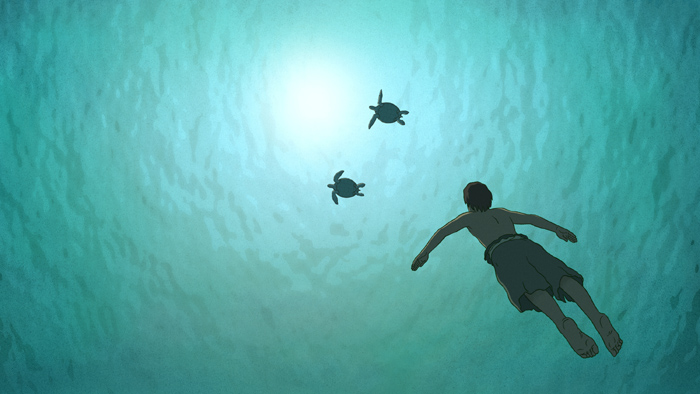 Image courtesy of Wild Bunch. © 2016 Studio Ghibli - Wild Bunch - Why Not Productions - Arte France Cinéma - CN4 Productions - Belvision - Nippon Television Network - Dentsu - Hakuhodo DYMP - Walt Disney Japan - Mitsubishi – Toho
Image courtesy of Wild Bunch. © 2016 Studio Ghibli - Wild Bunch - Why Not Productions - Arte France Cinéma - CN4 Productions - Belvision - Nippon Television Network - Dentsu - Hakuhodo DYMP - Walt Disney Japan - Mitsubishi – TohoAbout Studio Ghibli
Studio Ghibli was founded in 1985 by animation directors Hayao Miyazaki and Isao Takahata and is one of the most successful and well-respected animation studios in the world. Cultivating a creative force of talented directors, animators, and storytellers under the revered brilliance of Miyazaki and Takahata, Studio Ghibli’s films have been praised for their originality, dazzling animation, and epic storytelling. The films have become a beloved part of Japanese popular culture, and have garnered worldwide acclaim from audiences and critics alike. Hayao Miyazaki’s SPIRITED AWAY won the Academy Award for Best Animated Feature in 2002 and in 2005 Miyazaki was named one of "the most influential people" by Time Magazine.
About Wild Bunch
Wild Bunch is one of the world’s leading players in the field of international sales, its position strengthened by both a wealth of experience recognized by foreign distributors worldwide, and a broad, artistically diverse selection of the best of director-led international cinema. Currently handling an international sales catalogue of around 450 titles, Wild Bunch has established a reputation for both professionalism and provocation with distributors worldwide. Characterized by its diverse editorial policy, the company offers a constantly renewed and always innovative slate of films from all over the world: director-driven, art-house, genre or commercial; features, documentaries, regularly honored at both European and international festivals. Wild Bunch is also renowned for discovering -- and developing ongoing relationships with -- new and innovative directorial talent, having to date handled more than fifty first or second-time features. Wild Bunch has facilitated the international distribution and success of numerous films and is wholly committed to providing the finest in international cinema to distributors and broadcasters throughout the world.


